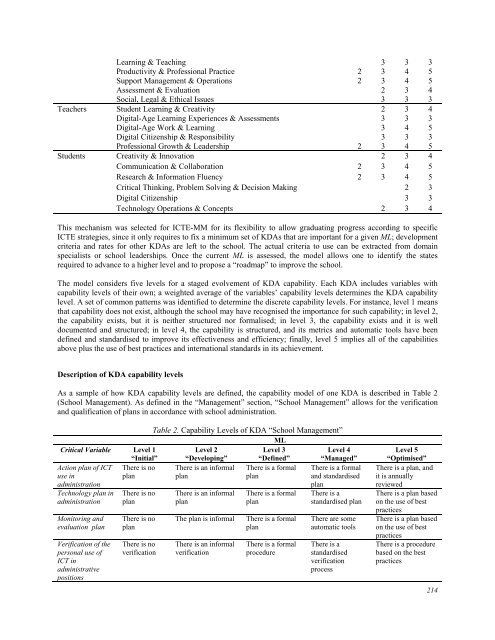A Maturity Model for Assessing the Use of ICT in School Education
A Maturity Model for Assessing the Use of ICT in School Education
A Maturity Model for Assessing the Use of ICT in School Education
You also want an ePaper? Increase the reach of your titles
YUMPU automatically turns print PDFs into web optimized ePapers that Google loves.
Learn<strong>in</strong>g & Teach<strong>in</strong>g 3 3 3<br />
Productivity & Pr<strong>of</strong>essional Practice 2 3 4 5<br />
Support Management & Operations 2 3 4 5<br />
Assessment & Evaluation 2 3 4<br />
Social, Legal & Ethical Issues 3 3 3<br />
Teachers Student Learn<strong>in</strong>g & Creativity 2 3 4<br />
Digital-Age Learn<strong>in</strong>g Experiences & Assessments 3 3 3<br />
Digital-Age Work & Learn<strong>in</strong>g 3 4 5<br />
Digital Citizenship & Responsibility 3 3 3<br />
Pr<strong>of</strong>essional Growth & Leadership 2 3 4 5<br />
Students Creativity & Innovation 2 3 4<br />
Communication & Collaboration 2 3 4 5<br />
Research & In<strong>for</strong>mation Fluency 2 3 4 5<br />
Critical Th<strong>in</strong>k<strong>in</strong>g, Problem Solv<strong>in</strong>g & Decision Mak<strong>in</strong>g 2 3<br />
Digital Citizenship 3 3<br />
Technology Operations & Concepts 2 3 4<br />
This mechanism was selected <strong>for</strong> <strong>ICT</strong>E-MM <strong>for</strong> its flexibility to allow graduat<strong>in</strong>g progress accord<strong>in</strong>g to specific<br />
<strong>ICT</strong>E strategies, s<strong>in</strong>ce it only requires to fix a m<strong>in</strong>imum set <strong>of</strong> KDAs that are important <strong>for</strong> a given ML; development<br />
criteria and rates <strong>for</strong> o<strong>the</strong>r KDAs are left to <strong>the</strong> school. The actual criteria to use can be extracted from doma<strong>in</strong><br />
specialists or school leaderships. Once <strong>the</strong> current ML is assessed, <strong>the</strong> model allows one to identify <strong>the</strong> states<br />
required to advance to a higher level and to propose a “roadmap” to improve <strong>the</strong> school.<br />
The model considers five levels <strong>for</strong> a staged evolvement <strong>of</strong> KDA capability. Each KDA <strong>in</strong>cludes variables with<br />
capability levels <strong>of</strong> <strong>the</strong>ir own; a weighted average <strong>of</strong> <strong>the</strong> variables’ capability levels determ<strong>in</strong>es <strong>the</strong> KDA capability<br />
level. A set <strong>of</strong> common patterns was identified to determ<strong>in</strong>e <strong>the</strong> discrete capability levels. For <strong>in</strong>stance, level 1 means<br />
that capability does not exist, although <strong>the</strong> school may have recognised <strong>the</strong> importance <strong>for</strong> such capability; <strong>in</strong> level 2,<br />
<strong>the</strong> capability exists, but it is nei<strong>the</strong>r structured nor <strong>for</strong>malised; <strong>in</strong> level 3, <strong>the</strong> capability exists and it is well<br />
documented and structured; <strong>in</strong> level 4, <strong>the</strong> capability is structured, and its metrics and automatic tools have been<br />
def<strong>in</strong>ed and standardised to improve its effectiveness and efficiency; f<strong>in</strong>ally, level 5 implies all <strong>of</strong> <strong>the</strong> capabilities<br />
above plus <strong>the</strong> use <strong>of</strong> best practices and <strong>in</strong>ternational standards <strong>in</strong> its achievement.<br />
Description <strong>of</strong> KDA capability levels<br />
As a sample <strong>of</strong> how KDA capability levels are def<strong>in</strong>ed, <strong>the</strong> capability model <strong>of</strong> one KDA is described <strong>in</strong> Table 2<br />
(<strong>School</strong> Management). As def<strong>in</strong>ed <strong>in</strong> <strong>the</strong> “Management” section, “<strong>School</strong> Management” allows <strong>for</strong> <strong>the</strong> verification<br />
and qualification <strong>of</strong> plans <strong>in</strong> accordance with school adm<strong>in</strong>istration.<br />
Table 2. Capability Levels <strong>of</strong> KDA “<strong>School</strong> Management”<br />
ML<br />
Critical Variable Level 1<br />
Level 2<br />
Level 3<br />
Level 4<br />
“Initial” “Develop<strong>in</strong>g” “Def<strong>in</strong>ed” “Managed”<br />
Action plan <strong>of</strong> <strong>ICT</strong> There is no There is an <strong>in</strong><strong>for</strong>mal There is a <strong>for</strong>mal There is a <strong>for</strong>mal<br />
use <strong>in</strong><br />
plan<br />
plan<br />
plan<br />
and standardised<br />
adm<strong>in</strong>istration<br />
plan<br />
Technology plan <strong>in</strong> There is no There is an <strong>in</strong><strong>for</strong>mal There is a <strong>for</strong>mal There is a<br />
adm<strong>in</strong>istration plan<br />
plan<br />
plan<br />
standardised plan<br />
Monitor<strong>in</strong>g and<br />
evaluation plan<br />
Verification <strong>of</strong> <strong>the</strong><br />
personal use <strong>of</strong><br />
<strong>ICT</strong> <strong>in</strong><br />
adm<strong>in</strong>istrative<br />
positions<br />
There is no<br />
plan<br />
There is no<br />
verification<br />
The plan is <strong>in</strong><strong>for</strong>mal There is a <strong>for</strong>mal<br />
plan<br />
There is an <strong>in</strong><strong>for</strong>mal<br />
verification<br />
There is a <strong>for</strong>mal<br />
procedure<br />
There are some<br />
automatic tools<br />
There is a<br />
standardised<br />
verification<br />
process<br />
Level 5<br />
“Optimised”<br />
There is a plan, and<br />
it is annually<br />
reviewed<br />
There is a plan based<br />
on <strong>the</strong> use <strong>of</strong> best<br />
practices<br />
There is a plan based<br />
on <strong>the</strong> use <strong>of</strong> best<br />
practices<br />
There is a procedure<br />
based on <strong>the</strong> best<br />
practices<br />
214
















